Effects of Landscape Pattern Change on Water Yield and Nonpoint Source Pollution in the Hun-Taizi River Watershed, China
Abstract
:1. Introduction
2. Materials and methods
2.1. Study Area
2.2. SWAT Model
2.2.1. SWAT Model Description
2.2.2. Data Collection and Model Parameter Setting
2.2.3. Model Calibration and Validation
2.2.4. Model Application
2.3. Statistical Analysis
2.3.1. Boosted Regression Tree
2.3.2. Landscape Metrics
2.3.3. Redundancy Analysis
3. Results
3.1. SWAT Model Calibration and Validation
3.2. Contribution of Land Use Changes to WYLD and Nutrient Yield Changes
3.3. Relationship Between Landscape Pattern Changes and WYLD and NPS changes
4. Discussion
4.1. Influence of Land Use Changes on WYLD and Nutrient Yield Changes
4.2. Influence of Landscape Pattern Changes on WYLD and NPS changes
4.3. Implications
5. Conclusions
Supplementary Materials
Author Contributions
Funding
Conflicts of Interest
References
- Sun, F.Y.; Mejia, A.; Che, Y. Disentangling the Contributions of Climate and Basin Characteristics to Water Yield Across Spatial and Temporal Scales in the Yangtze River Basin: A Combined Hydrological Model and Boosted Regression Approach. Water Resour. Manag. 2019, 33, 3449–3468. [Google Scholar] [CrossRef]
- Xu, Z.X.; Pang, J.P.; Liu, C.M.; Li, J.Y. Assessment of runoff and sediment yield in the Miyun Reservoir catchment by using SWAT model. Hydrol. Process. 2009, 23, 3619–3630. [Google Scholar] [CrossRef]
- Tang, L.H.; Yang, D.W.; Hu, H.P.; Gao, B. Detecting the effect of land-use change on streamflow, sediment and nutrient losses by distributed hydrological simulation. J. Hydrol. 2011, 409, 172–182. [Google Scholar] [CrossRef]
- Zhang, J.; Li, S.Y.; Dong, R.Z.; Jiang, C.S.; Ni, M.F. Influences of land use metrics at multi-spatial scales on seasonal water quality: A case study of river systems in the Three Gorges Reservoir Area, China. J. Clean. Prod. 2019, 206, 76–85. [Google Scholar] [CrossRef]
- Ouyang, W.; Skidmore, A.K.; Toxopeus, A.G.; Hao, F.H. Long-term vegetation landscape pattern with non-point source nutrient pollution in upper stream of Yellow River basin. J. Hydrol. 2010, 389, 373–380. [Google Scholar] [CrossRef]
- Ouyang, W.; Song, K.Y.; Wang, X.L.; Hao, F.H. Non-point source pollution dynamics under long-term agricultural development and relationship with landscape dynamics. Ecol. Indic. 2014, 45, 579–589. [Google Scholar] [CrossRef]
- Xiang, C.Y.; Wang, Y.; Liu, H.W. A scientometrics review on nonpoint source pollution research. Ecol. Eng. 2017, 99, 400–408. [Google Scholar] [CrossRef]
- Heathman, G.C.; Flanagan, D.C.; Larose, M.; Zuercher, B.W. Application of the Soil and Water Assessment Tool and Annualized Agricultural Non-Point Source models in the St. Joseph River watershed. J. Soil Water Conserv. 2008, 63, 552–568. [Google Scholar] [CrossRef] [Green Version]
- Beasley, D.B.; Huggins, L.F.; Monke, E.J. Answers—A Model For Watershed Planning. Trans. ASAE 1980, 23, 938–944. [Google Scholar] [CrossRef]
- Tong, S.T.Y.; Chen, W.L. Modeling the relationship between land use and surface water quality. J. Environ. Manag. 2002, 66, 377–393. [Google Scholar] [CrossRef]
- Williams, R.D.; Nicks, A.D. Using creams to simulate filter strip effectiveness in erosion control. J. Soil Water Conserv. 1988, 43, 108–112. [Google Scholar]
- Xie, H.I.; Shen, Z.Y.; Chen, L.; Qiu, J.L.; Dong, J.W. Time-varying sensitivity analysis of hydrologic and sediment parameters at multiple timescales: Implications for conservation practices. Sci. Total Environ. 2017, 598, 353–364. [Google Scholar] [CrossRef] [PubMed]
- Arnold, J.G.; Srinivasan, R.; Muttiah, R.S.; Williams, J.R. Large area hydrologic modeling and assessment—Part 1: Model development. J. Am. Water Resour. Assoc. 1998, 34, 73–89. [Google Scholar] [CrossRef]
- Epelde, A.M.; Cerro, I.; Sanchez-Perez, J.M.; Sauvage, S.; Srinivasan, R.; Antiguedad, I. Application of the SWAT model to assess the impact of changes in agricultural management practices on water quality. Hydrol. Sci. J. 2015, 60, 825–843. [Google Scholar] [CrossRef]
- Abbaspour, K.C.; Yang, J.; Maximov, I.; Siber, R.; Bogner, K.; Mieleitner, J.; Zobrist, J.; Srinivasan, R. Modelling hydrology and water quality in the pre-alpine/alpine Thur watershed using SWAT. J. Hydrol. 2007, 333, 413–430. [Google Scholar] [CrossRef]
- Shen, Z.Y.; Qiu, J.L.; Hong, Q.; Chen, L. Simulation of spatial and temporal distributions of non-point source pollution load in the Three Gorges Reservoir Region. Sci. Total Environ. 2014, 493, 138–146. [Google Scholar] [CrossRef]
- Xu, K.; Wang, Y.P.; Su, H.; Yang, J.X.; Li, L.L.; Liu, C. Effect of land-use changes on nonpoint source pollution in the Xizhi River watershed, Guangdong, China. Hydrol. Process. 2013, 27, 2557–2566. [Google Scholar] [CrossRef]
- Wang, G.Q.; Yang, H.C.; Wang, L.J.; Xu, Z.X.; Xue, B.L. Using the SWAT model to assess impacts of land use changes on runoff generation in headwaters. Hydrol. Process. 2014, 28, 1032–1042. [Google Scholar] [CrossRef]
- Yang, H.C.; Wang, G.Q.; Wang, L.J.; Zheng, B.H. Impact of land use changes on water quality in headwaters of the Three Gorges Reservoir. Environ. Sci. Pollut. Res. 2016, 23, 11448–11460. [Google Scholar] [CrossRef]
- Fu, Q.; Shi, R.; Li, T.X.; Sun, Y.K.; Liu, D.; Cui, S.; Hou, R.J. Effects of land-use change and climate variability on streamflow in the Woken River basin in Northeast China. River Res. Appl. 2019, 35, 121–132. [Google Scholar] [CrossRef]
- Shi, P.; Zhang, Y.; Li, Z.B.; Li, P.; Xu, G.C. Influence of land use and land cover patterns on seasonal water quality at multi-spatial scales. Catena 2017, 151, 182–190. [Google Scholar] [CrossRef]
- He, C.S.; Malcolm, S.B.; Dahlberg, K.A.; Fu, B.J. A conceptual framework for integrating hydrological and biological indicators into watershed management. Landsc. Urban Plan. 2000, 49, 25–34. [Google Scholar] [CrossRef]
- Liu, M.; Li, C.L.; Hu, Y.M.; Sun, F.Y.; Xu, Y.Y.; Chen, T. Combining CLUE-S and SWAT models to forecast land use change and non-point source pollution impact at a watershed scale in Liaoning Province, China. Chin. Geogr. Sci. 2014, 24, 540–550. [Google Scholar] [CrossRef] [Green Version]
- Liaoning Provincial Bureau of Statistics. Liaoning Statistical Yearbook 2017; China Statistics Press: Beijing, China, 2017. [Google Scholar]
- Arnold, J.G.; Moriasi, D.N.; Gassman, P.W.; Abbaspour, K.C.; White, M.J.; Srinivasan, R.; Santhi, C.; Harmel, R.D.; van Griensven, A.; Van Liew, M.W.; et al. SWAT: model use, calibration, and validation. Trans. ASABE 2012, 55, 1491–1508. [Google Scholar] [CrossRef]
- Arnold, J.G.; Fohrer, N. SWAT2000: Current capabilities and research opportunities in applied watershed modelling. Hydrol. Process. 2005, 19, 563–572. [Google Scholar] [CrossRef]
- Gassman, P.W.; Reyes, M.R.; Green, C.H.; Arnold, J.G. The soil and water assessment tool: Historical development, applications, and future research directions. Trans. ASABE 2007, 50, 1211–1250. [Google Scholar] [CrossRef] [Green Version]
- Ye, Y. A Study on the Relationship between Landscape and Water Quality in the Upper Reaches Watershed of Hun River; Chinese Academy of Sciences: Shenyang, China, 2014. [Google Scholar]
- Abbaspour, K.C.; Rouholahnejad, E.; Vaghefi, S.; Srinivasan, R.; Yang, H.; Klove, B. A continental-scale hydrology and water quality model for Europe: Calibration and uncertainty of a high-resolution large-scale SWAT model. J. Hydrol. 2015, 524, 733–752. [Google Scholar] [CrossRef] [Green Version]
- Nash, J.E.; Sutcliffe, J.V. River flow forecasting through conceptual models part I A discussion of principles. J. Hydrol. 1970, 10, 282–290. [Google Scholar] [CrossRef]
- Parajuli, P.B. Assessing sensitivity of hydrologic responses to climate change from forested watershed in Mississippi. Hydrol. Process. 2010, 24, 3785–3797. [Google Scholar] [CrossRef]
- Moriasi, D.N.; Arnold, J.G.; Van Liew, M.W.; Bingner, R.L.; Harmel, R.D.; Veith, T.L. Model evaluation guidelines for systematic quantification of accuracy in watershed simulations. Trans. ASABE 2007, 50, 885–900. [Google Scholar] [CrossRef]
- Parajuli, P.B.; Mankin, K.R.; Barnes, P.L. Source specific fecal bacteria modeling using soil and water assessment tool model. Bioresour. Technol. 2009, 100, 953–963. [Google Scholar] [CrossRef] [PubMed]
- Yan, B.; Fang, N.F.; Zhang, P.C.; Shi, Z.H. Impacts of land use change on watershed streamflow and sediment yield: An assessment using hydrologic modelling and partial least squares regression. J. Hydrol. 2013, 484, 26–37. [Google Scholar] [CrossRef]
- Wang, G.S.; Xia, J.; Chen, J. Quantification of effects of climate variations and human activities on runoff by a monthly water balance model: A case study of the Chaobai River basin in northern China. Water Resour. Res. 2009, 45, 12. [Google Scholar] [CrossRef] [Green Version]
- Elith, J.; Leathwick, J.R.; Hastie, T. A working guide to boosted regression trees. J. Anim. Ecol. 2008, 77, 802–813. [Google Scholar] [CrossRef] [PubMed]
- De’ath, G. Boosted trees for ecological modeling and prediction. Ecology 2007, 88, 243–251. [Google Scholar] [CrossRef]
- Li, C.L.; Liu, M.; Hu, Y.M.; Shi, T.; Qu, X.Q.; Walter, M.T. Effects of urbanization on direct runoff characteristics in urban functional zones. Sci. Total Environ. 2018, 643, 301–311. [Google Scholar] [CrossRef]
- Hao, F.H.; Zhang, X.; Wang, X.; Ouyang, W. Assessing the Relationship Between Landscape Patterns and Nonpoint-Source Pollution in the Danjiangkou Reservoir Basin in China. J. Am. Water Resour. Assoc. 2012, 48, 1162–1177. [Google Scholar] [CrossRef]
- Shen, Z.Y.; Hou, X.S.; Li, W.; Aini, G. Relating landscape characteristics to non-point source pollution in a typical urbanized watershed in the municipality of Beijing. Landsc. Urban Plan. 2014, 123, 96–107. [Google Scholar] [CrossRef]
- Zhang, L.; Lu, W.; Hou, G.; Gao, H.; Liu, H.; Zheng, Y. Coupled analysis on land use, landscape pattern and nonpoint source pollution loads in Shitoukoumen Reservoir watershed, China. Sustain. Cities Soc. 2019, 51. [Google Scholar] [CrossRef]
- Gilliam, F.S.; Saunders, N.E. Making more sense of the order: A review of Canoco for Windows 4.5, PC-ORD version 4 and SYN-TAX 2000. J. Veg. Sci. 2003, 14, 297–304. [Google Scholar] [CrossRef]
- Chen, Y.; Cheng, S.Y.; Liu, L.; Guo, X.R.; Wang, Z.; Qin, C.H.; Hao, R.X.; Lu, J.; Gao, J.J. Assessing the Effects of Land Use Changes on Non-Point Source Pollution Reduction for the Three Gorges Watershed Using the SWAT Model. J. Environ. Inform. 2013, 22, 13–26. [Google Scholar] [CrossRef]
- Lee, S.W.; Hwang, S.J.; Lee, S.B.; Hwang, H.S.; Sung, H.C. Landscape ecological approach to the relationships of land use patterns in watersheds to water quality characteristics. Landsc. Urban Plan. 2009, 92, 80–89. [Google Scholar] [CrossRef]
- Yao, Y.F.; Cai, T.J.; Wei, X.H.; Zhang, M.F.; Ju, C.Y. Effect of forest recovery on summer streamflow in small forested watersheds, Northeastern China. Hydrol. Process. 2012, 26, 1208–1214. [Google Scholar] [CrossRef]
- Liu, W.B.; Cai, T.J.; Fu, G.B.; Zhang, A.J.; Liu, C.M.; Yu, H.Z. The streamflow trend in Tangwang River basin in northeast China and its difference response to climate and land use change in sub-basins. Environ. Earth Sci. 2013, 69, 51–62. [Google Scholar] [CrossRef]
- Chen, L.D.; Messing, I.; Zhang, S.R.; Fu, B.J.; Ledin, S. Land use evaluation and scenario analysis towards sustainable planning on the Loess Plateau in China—Case study in a small catchment. Catena 2003, 54, 303–316. [Google Scholar] [CrossRef]
- Turner, R.E.; Rabalais, N.N. Linking landscape and water quality in the Mississippi river basin for 200 years. Bioscience 2003, 53, 563–572. [Google Scholar] [CrossRef]
- Li, Y.L.; Liu, K.; Li, L.; Xu, Z.X. Relationship of land use/cover on water quality in the Liao River basin, China. In 18th Biennial Isem Conference on Ecological Modelling for Global Change and Coupled Human and Natural System; Yang, Z., Chen, B., Eds.; Elsevier Science BV: Amsterdam, The Netherlands, 2012; Volume 13, pp. 1484–1493. [Google Scholar]
- Jeon, J.H.; Yoon, C.G.; Ham, J.H.; Jung, K.W. Model development for nutrient loading estimates from paddy rice fields in Korea. J. Environ. Sci. Health Part B-Pestic. Contam. Agric. Wastes 2004, 39, 845–860. [Google Scholar] [CrossRef]
- Yao, Y.F.; Cai, T.J.; Ju, C.Y.; He, C.X. Effect of reforestation on annual water yield in a large watershed in northeast China. J. For. Res. 2015, 26, 697–702. [Google Scholar] [CrossRef]
- Shi, C.; Yuan, S.B.; Shi, C.Q.; Zhao, T.N. Estimating the Effect of Precipitation and Vegetation on Water Yield in Northern China. Pol. J. Environ. Stud. 2018, 27, 305–311. [Google Scholar] [CrossRef]
- Rajaei, F.; Sari, A.E.; Salmanmahiny, A.; Delavar, M.; Bavani, A.R.M.; Srinivasan, R. Surface drainage nitrate loading estimate from agriculture fields and its relationship with landscape metrics in Tajan watershed. Paddy Water Environ. 2017, 15, 541–552. [Google Scholar] [CrossRef]
- Li, C.W.; Zhang, Y.J.; Kharel, G.; Zou, C.B. Impact of Climate Variability and Landscape Patterns on Water Budget and Nutrient Loads in a Peri-urban Watershed: A Coupled Analysis Using Process-based Hydrological Model and Landscape Indices. Environ. Manag. 2018, 61, 954–967. [Google Scholar] [CrossRef] [PubMed]
- Xu, J.W.; Liu, S.L.; Zhao, S.; Wu, X.; Hou, X.Y.; An, Y.; Shen, Z.Y. Spatiotemporal Dynamics of Water Yield Service and Its Response to Urbanisation in the Beiyun River Basin, Beijing. Sustainability 2019, 11, 4361. [Google Scholar] [CrossRef] [Green Version]
- Xi, F.-M.; He, H.-S.; Hu, Y.-M.; Wu, X.-Q.; Chang, Y.; Liu, M.; Shi, T.-M.; Wang, J.-N. Spatiotemporal pattern of urban growth and its driving forces in urban agglomeration of central Liaoning Province, China. Ying Yong Sheng Tai Xue Bao 2010, 21, 707–713. [Google Scholar] [PubMed]
- Andaryani, S.; Trolle, D.; Nikjoo, M.R.; Moghadam, M.H.R.; Mokhtari, D. Forecasting near-future impacts of land use and climate change on the Zilbier river hydrological regime, northwestern Iran. Environ. Earth Sci. 2019, 78, 14. [Google Scholar] [CrossRef]
- Shrestha, S.; Bhatta, B.; Shrestha, M.; Shrestha, P.K. Integrated assessment of the climate and landuse change impact on hydrology and water quality in the Songkhram River Basin, Thailand. Sci. Total Environ. 2018, 643, 1610–1622. [Google Scholar] [CrossRef] [PubMed]
- Yang, H.C.; Wang, G.Q.; Yang, Y.; Xue, B.L.; Wu, B.B. Assessment of the Impacts of Land Use Changes on Nonpoint Source Pollution Inputs Upstream of the Three Gorges Reservoir. Sci. World J. 2014, 1–15. [Google Scholar] [CrossRef]
- Baker, T.J.; Miller, S.N. Using the Soil and Water Assessment Tool (SWAT) to assess land use impact on water resources in an East African watershed. J. Hydrol. 2013, 486, 100–111. [Google Scholar] [CrossRef]
- Zhou, T.; Wu, J.G.; Peng, S.L. Assessing the effects of landscape pattern on river water quality at multiple scales: A case study of the Dongjiang River watershed, China. Ecol. Indic. 2012, 23, 166–175. [Google Scholar] [CrossRef]
- Chen, L.; Dai, Y.; Zhi, X.S.; Xie, H.; Shen, Z.Y. Quantifying nonpoint source emissions and their water quality responses in a complex catchment: A case study of a typical urban-rural mixed catchment. J. Hydrol. 2018, 559, 110–121. [Google Scholar] [CrossRef]

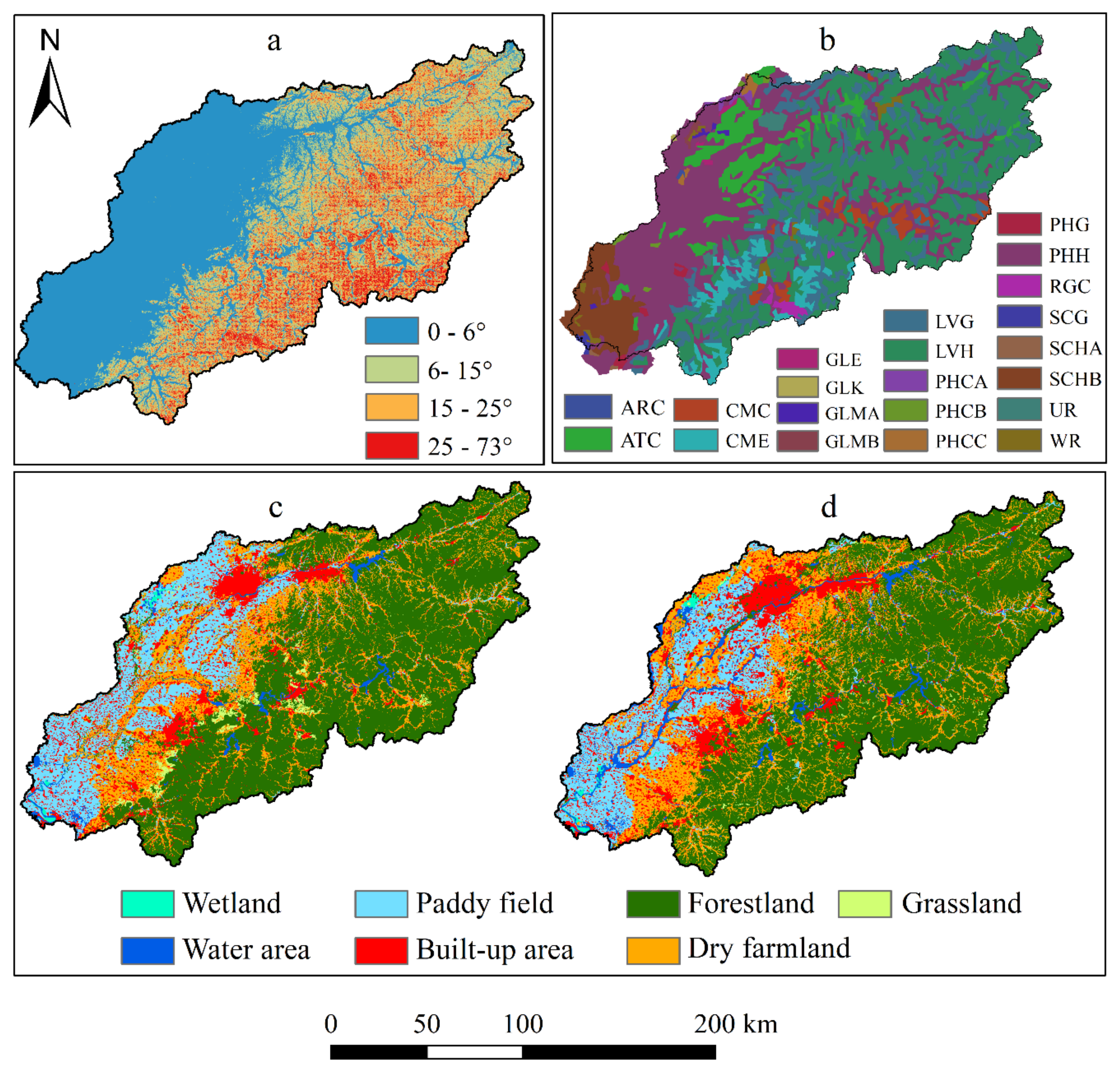
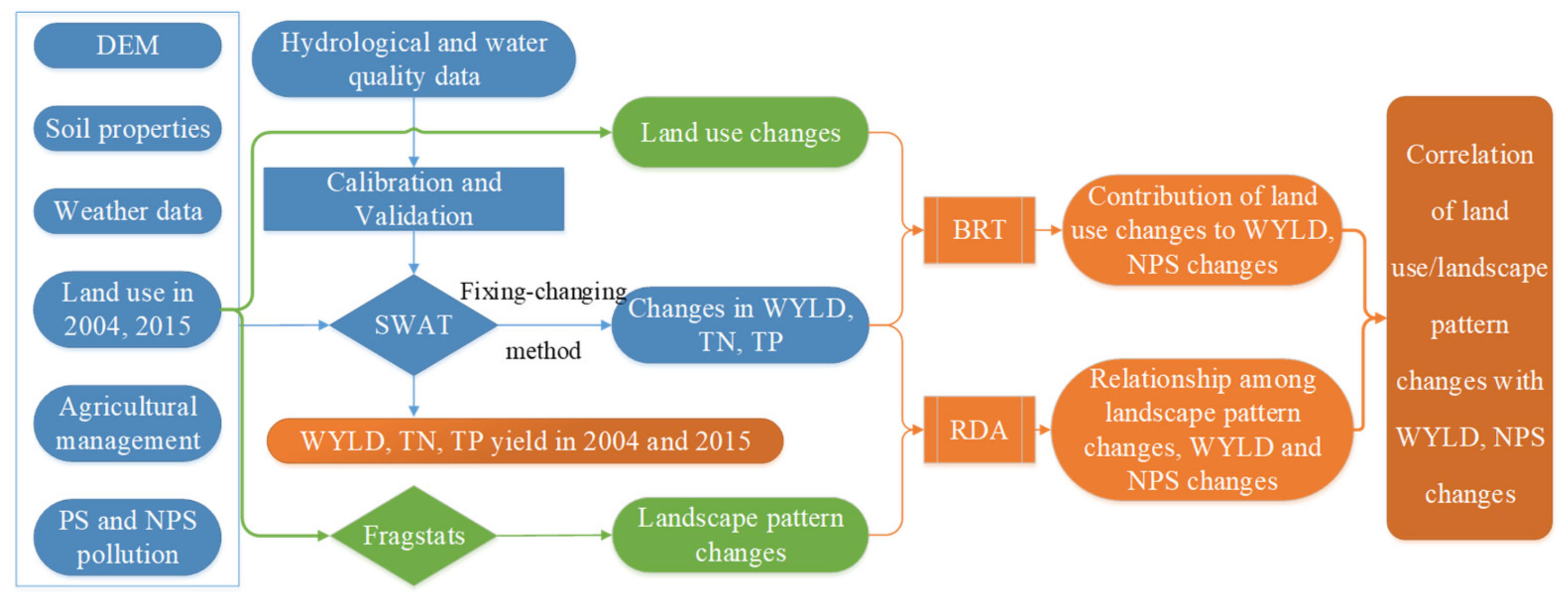
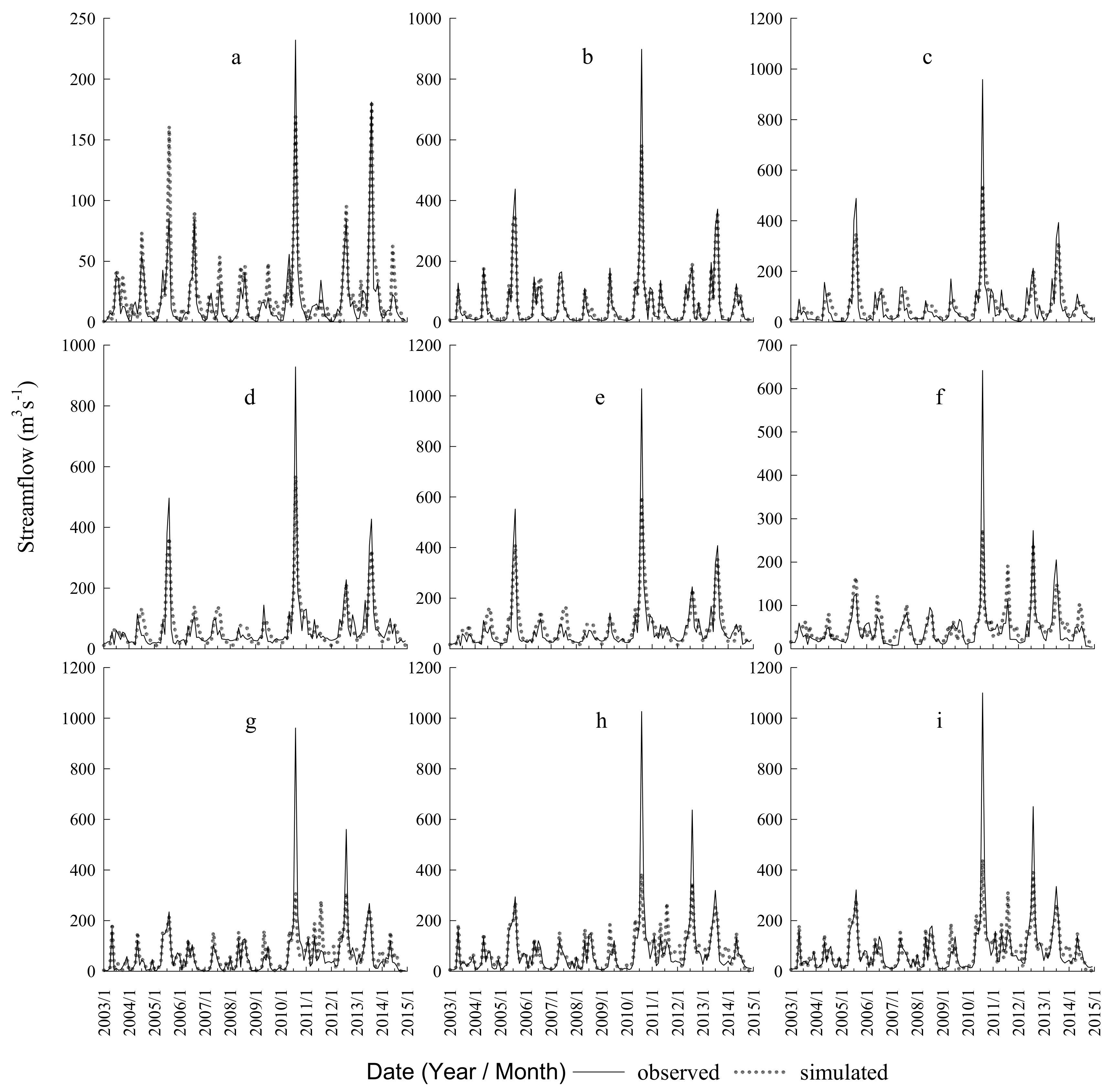

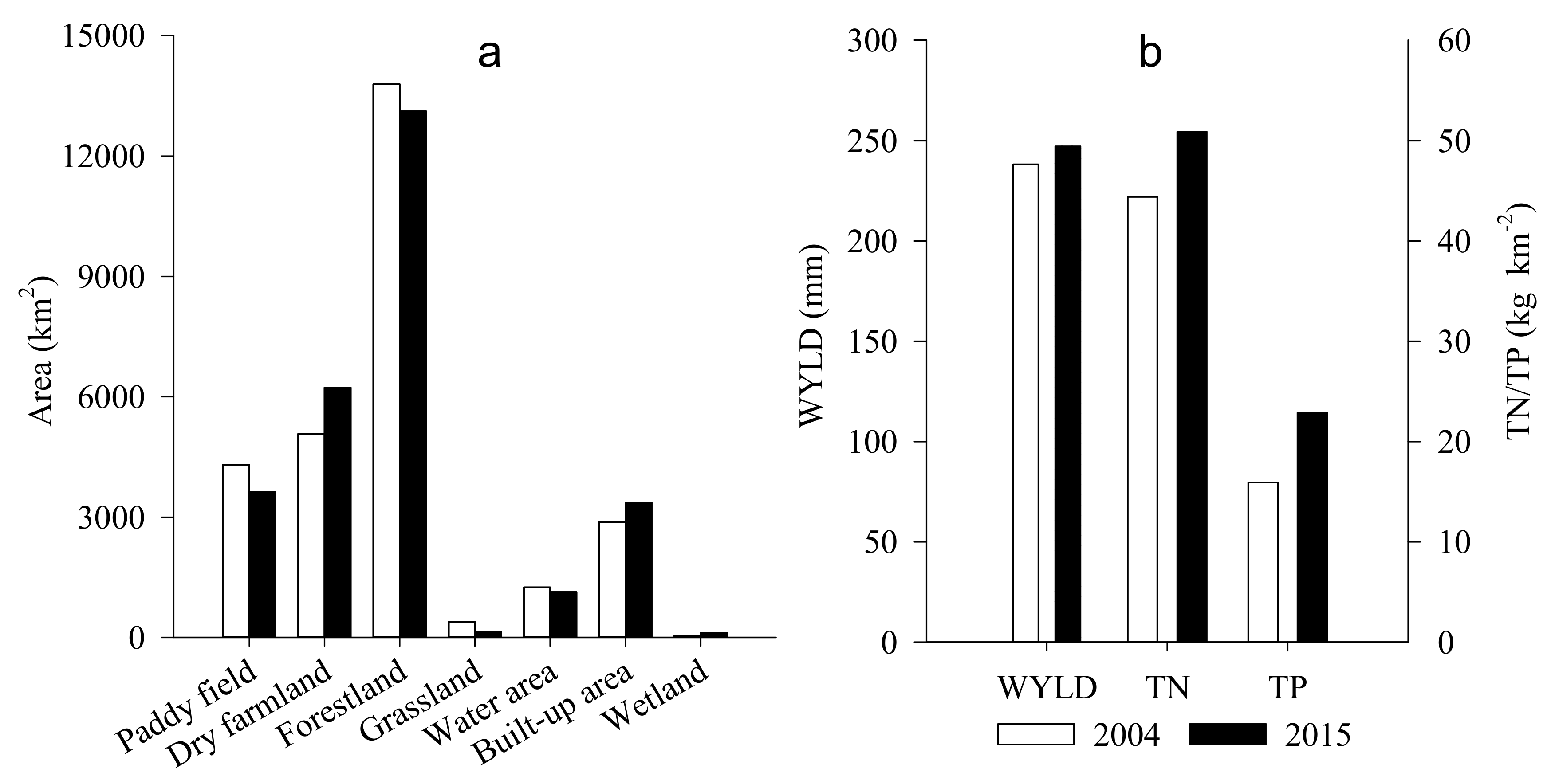
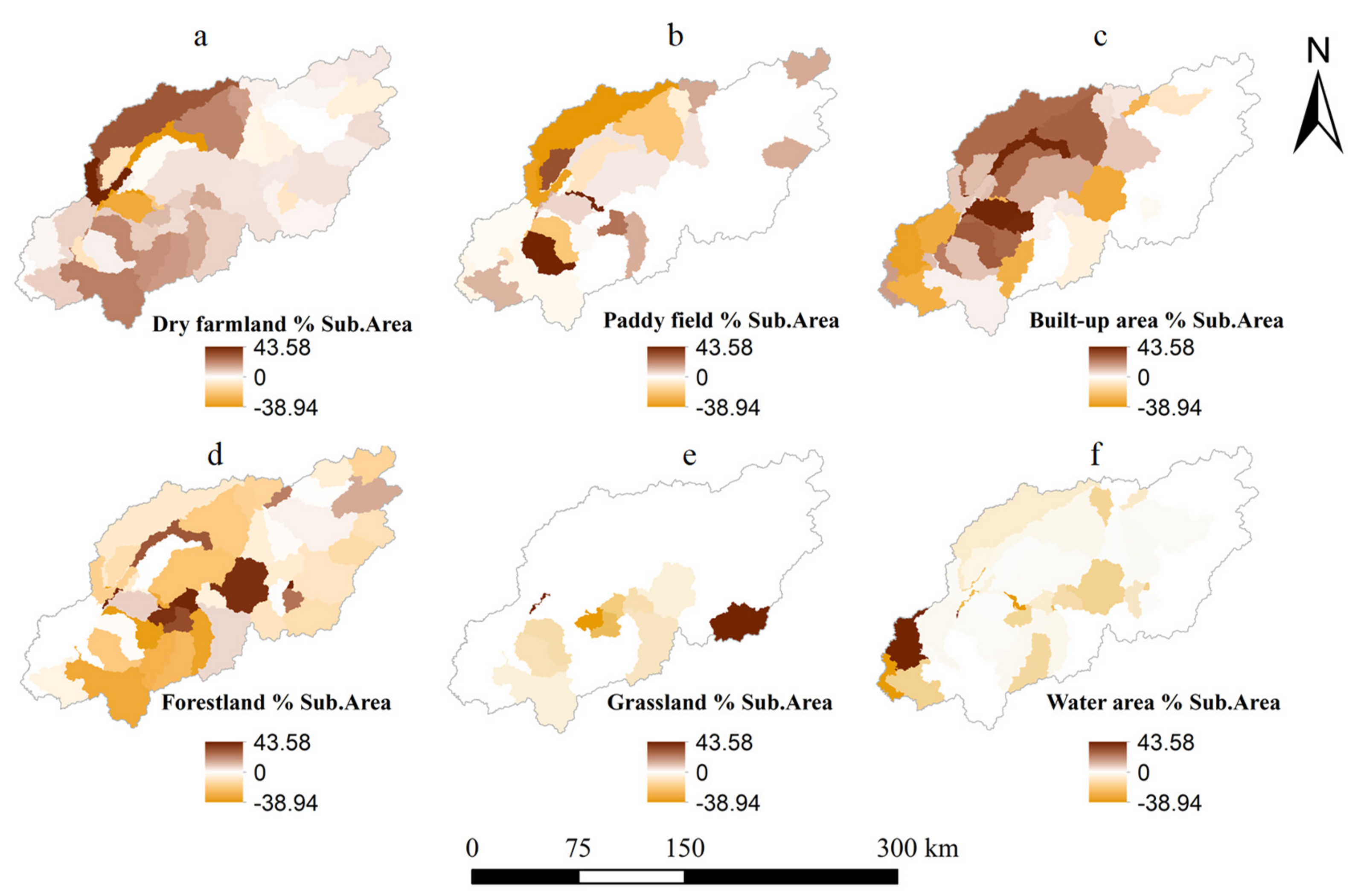
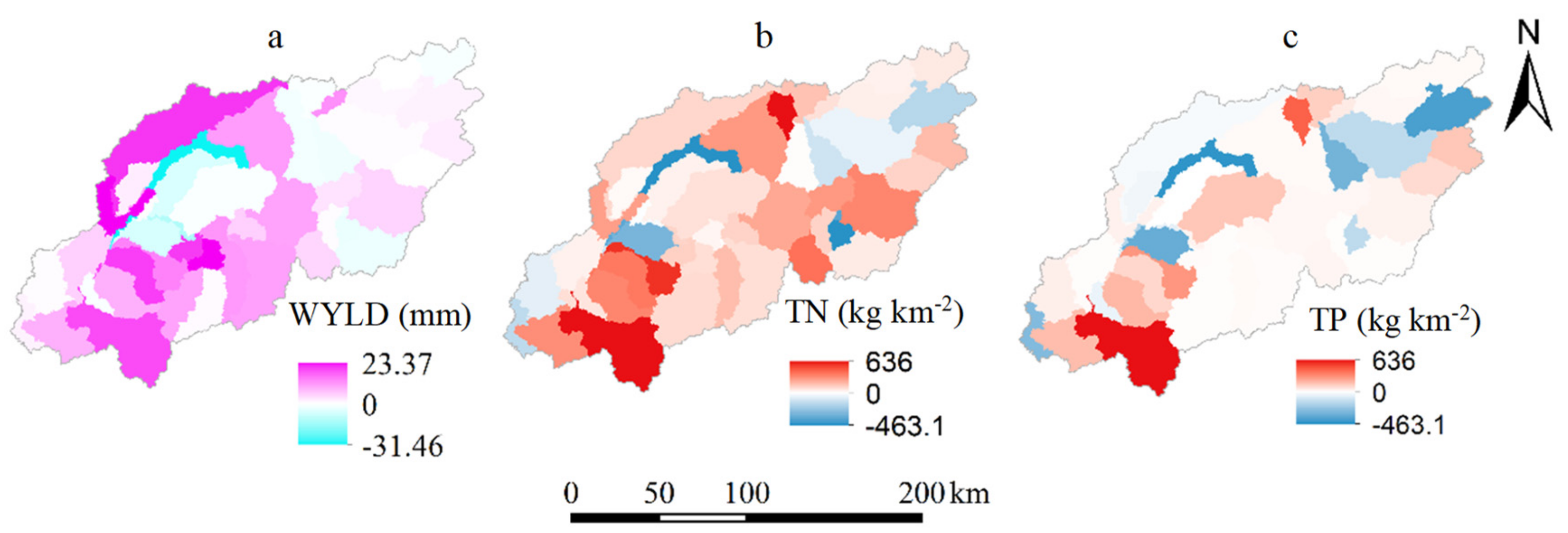
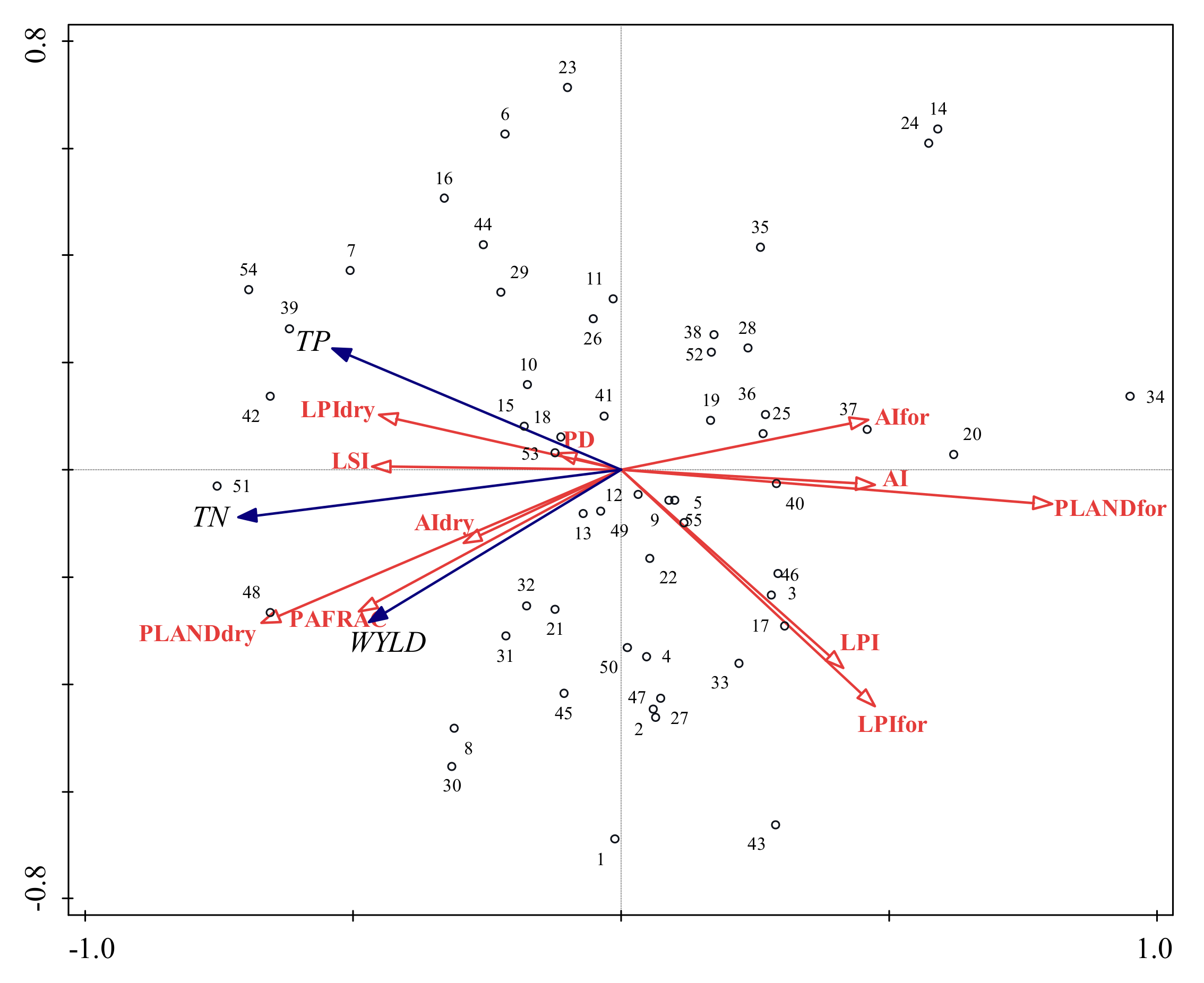
| Data | Data Format | Data Description | Data Source |
|---|---|---|---|
| Digital elevation model (DEM) | Vector map (1:5000) | Elevation, slopes (Figure 2a) | Liaoning Surveying and Mapping Bureau |
| Soil map and properties | Grid (cell size, 0.0083333333°) | Physical and chemical properties of soils (Figure 2b) | Harmonized World Soil Database (Version1.2) (http://www.fao.org/nr/land/soils/harmonized-world-soil-database/en/) |
| Land use map | Grid (cell size, 30 × 30 m) | Land use classification in 2004 (Figure 2c) and 2015 (Figure 2d) | Landsat 5 Thematic Mapper and Landsat 8 Operational Land Imager (https://earthexplorer.usgs.gov/) |
| Weather | Database file (DBF) | Including daily data of precipitation, maximum and minimum temperature, humidity and wind speed | China Meteorological Administration (https://data.cma.cn/); Local Bureau of Meteorology |
| Hydrology and water quality data | Database file (DBF) | Monthly observed streamflow data, maximum and minimum discharge data of the four reservoirs, and monthly observed nutrient yield | Local hydrographical station and environmental monitoring station |
| Agricultural management | Database file (DBF) | Including crop planting time, fertilization, and harvested time | Liaoning statistical bureau and field survey |
| Point and nonpoint source data | Database file (DBF) | PS: Urban population and industrial production NPS: Rural population and livestock rearing | Liaoning statistical yearbooks (http://www.ln.stats.gov.cn/tjsj/sjcx/ndsj/) |
| Stations | Calibration | Validation | |||
|---|---|---|---|---|---|
| R2 | ENS | R2 | ENS | ||
| Streamflow | Beikouqian | 0.80 | 0.77 | 0.88 | 0.87 |
| Fushun | 0.95 | 0.90 | 0.99 | 0.98 | |
| Shenyang | 0.86 | 0.77 | 0.80 | 0.78 | |
| Huanglatuo | 0.85 | 0.80 | 0.82 | 0.80 | |
| Xingjiawopeng | 0.82 | 0.77 | 0.78 | 0.78 | |
| Benxi | 0.72 | 0.63 | 0.68 | 0.65 | |
| Laioyang | 0.64 | 0.58 | 0.67 | 0.64 | |
| Xiaolinzi | 0.70 | 0.64 | 0.72 | 0.69 | |
| Tangmazhai | 0.73 | 0.66 | 0.76 | 0.74 | |
| TN | Shenyang | 0.63 | 0.39 | 0.95 | 0.87 |
| Xingjiawopeng | 0.76 | 0.36 | 0.78 | 0.58 | |
| Liaoyang | 0.94 | 0.78 | - | - | |
| Xiaolinzi | 0.91 | 0.73 | - | - | |
| TP | Shenyang | 0.92 | 0.66 | 0.91 | 0.61 |
| Xingjiawopeng | 0.77 | 0.55 | 0.90 | 0.81 | |
| Liaoyang | 0.66 | 0.65 | 0.90 | 0.72 | |
| Xiaolinzi | 0.96 | 0.90 | 0.66 | 0.58 | |
| WYLD | TN | TP | |
|---|---|---|---|
| Dry farmland | +42.03 | +54.30 | +25.55 |
| Paddy field | −17.06 | −2.72 | −4.35 |
| Forestland | −3.58 | −22.26 | −29.78 |
| Grassland | 0 | 0 | 0 |
| Water area | −13.55 | +9.21 | +15.37 |
| Built-up area | +23.79 | +11.50 | +24.95 |
| Variables | Contribution (%) | Significance | Variables | Contribution (%) | Significance |
|---|---|---|---|---|---|
| PLANDfor | 28.0 | 0.002 | LSI | 9.3 | 0.02 |
| PLANDdry | 19.7 | 0.006 | AIfor | 9.2 | 0.034 |
| PAFRAC | 10.5 | 0.008 | LPIdry | 8.9 | 0.036 |
| LPIfor | 10.2 | 0.012 | AIdry | 8.5 | 0.038 |
| AI | 9.7 | 0.028 | LPI | 7.8 | 0.04 |
© 2020 by the authors. Licensee MDPI, Basel, Switzerland. This article is an open access article distributed under the terms and conditions of the Creative Commons Attribution (CC BY) license (http://creativecommons.org/licenses/by/4.0/).
Share and Cite
Zong, M.; Hu, Y.; Liu, M.; Li, C.; Wang, C.; Ping, X. Effects of Landscape Pattern Change on Water Yield and Nonpoint Source Pollution in the Hun-Taizi River Watershed, China. Int. J. Environ. Res. Public Health 2020, 17, 3060. https://doi.org/10.3390/ijerph17093060
Zong M, Hu Y, Liu M, Li C, Wang C, Ping X. Effects of Landscape Pattern Change on Water Yield and Nonpoint Source Pollution in the Hun-Taizi River Watershed, China. International Journal of Environmental Research and Public Health. 2020; 17(9):3060. https://doi.org/10.3390/ijerph17093060
Chicago/Turabian StyleZong, Min, Yuanman Hu, Miao Liu, Chunlin Li, Cong Wang, and Xiaoying Ping. 2020. "Effects of Landscape Pattern Change on Water Yield and Nonpoint Source Pollution in the Hun-Taizi River Watershed, China" International Journal of Environmental Research and Public Health 17, no. 9: 3060. https://doi.org/10.3390/ijerph17093060





